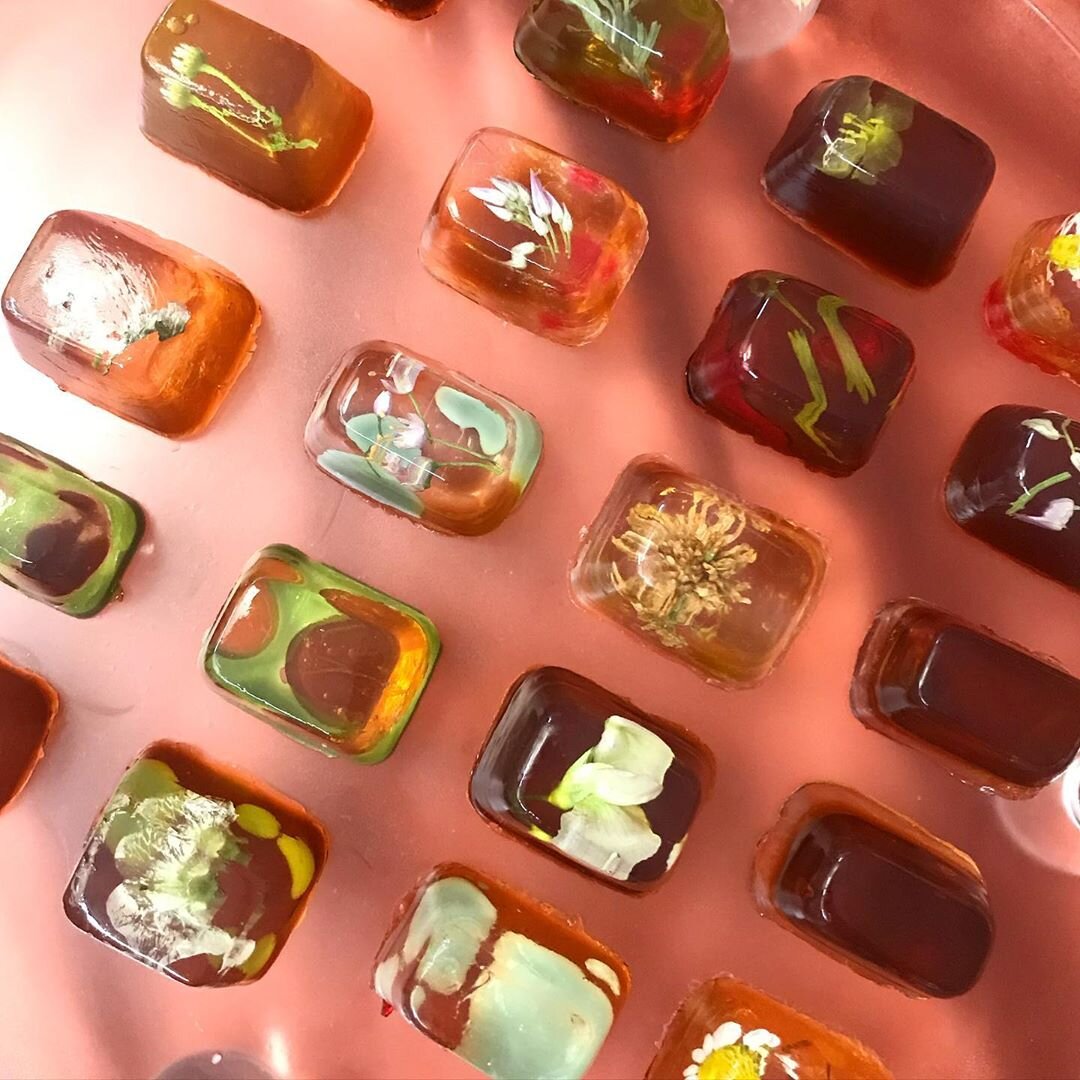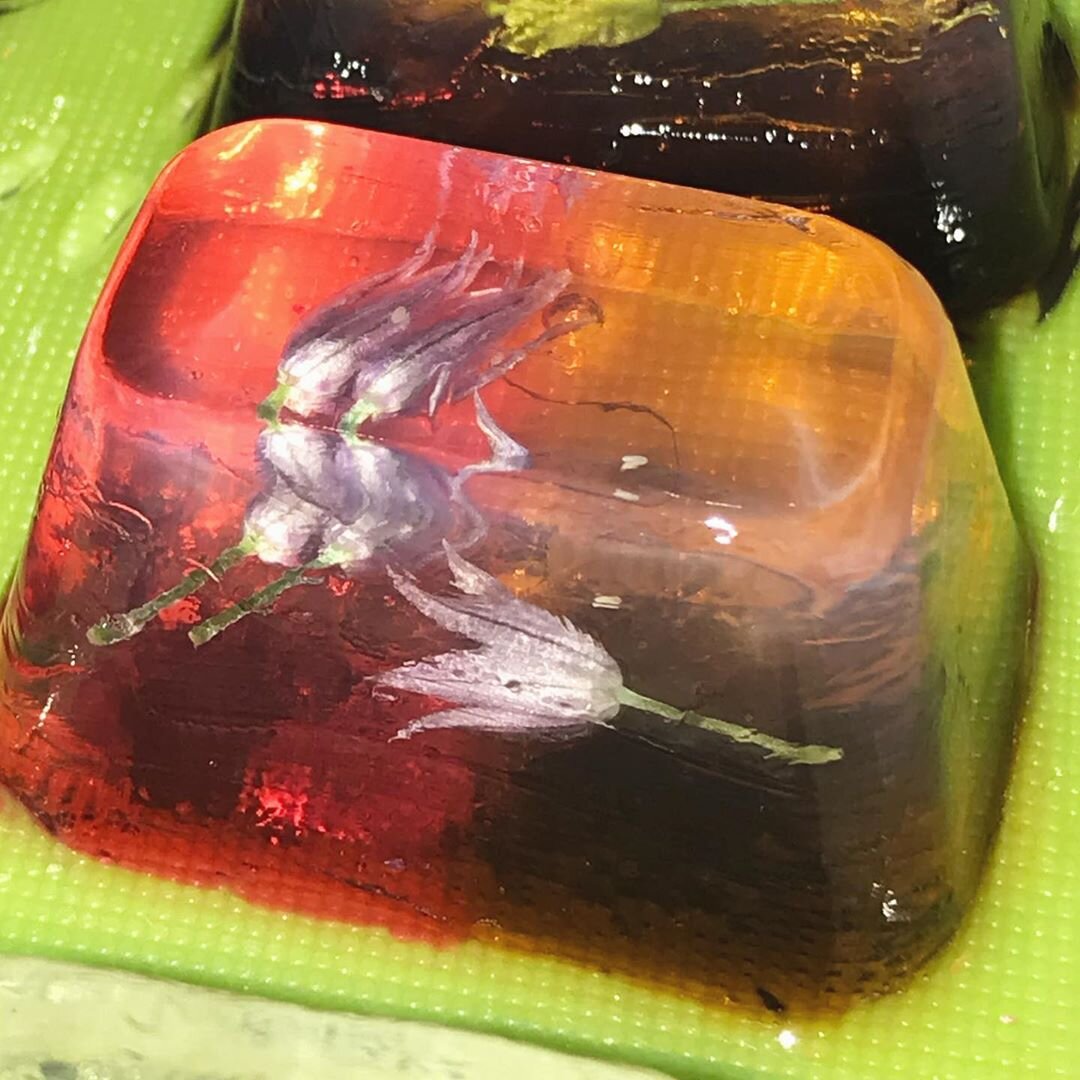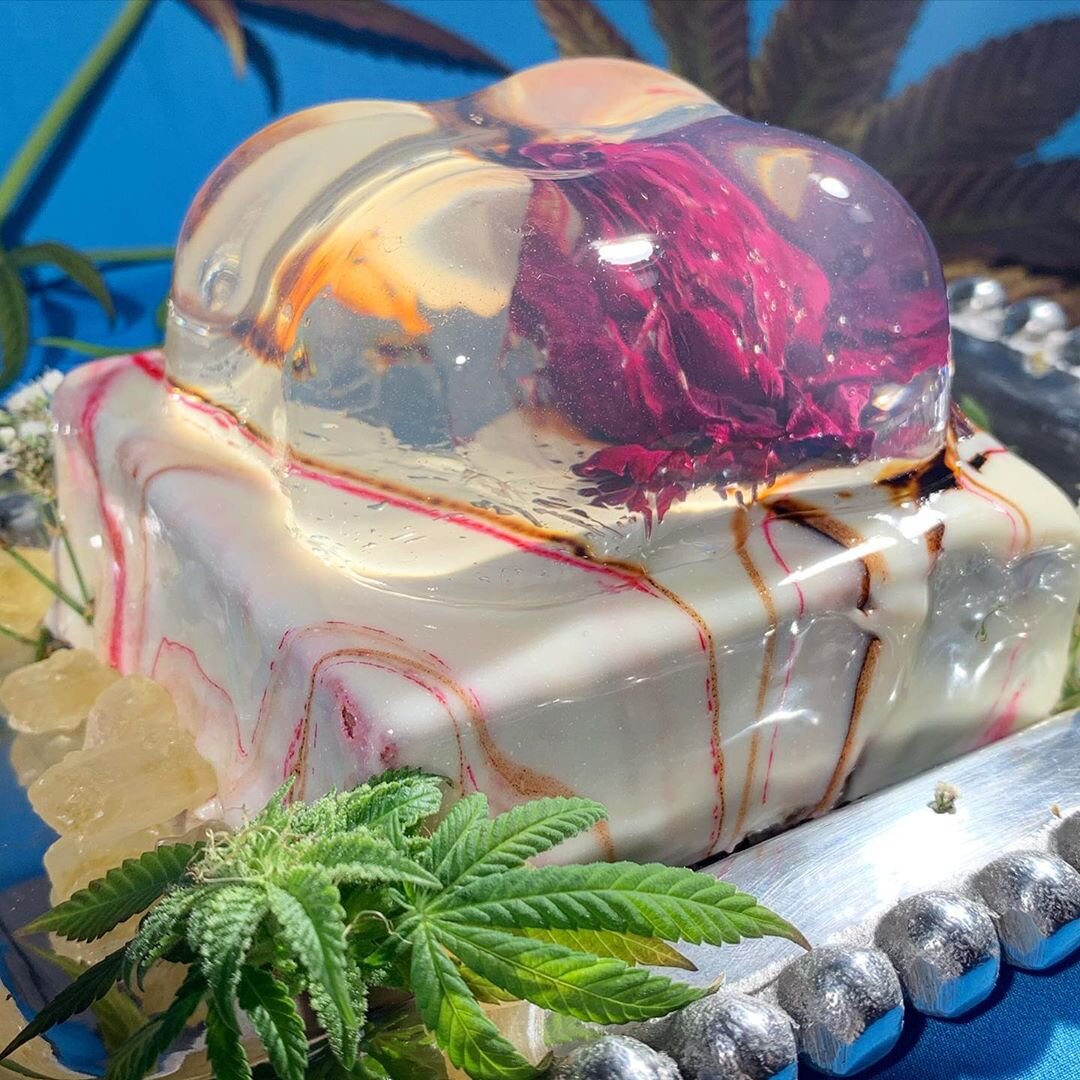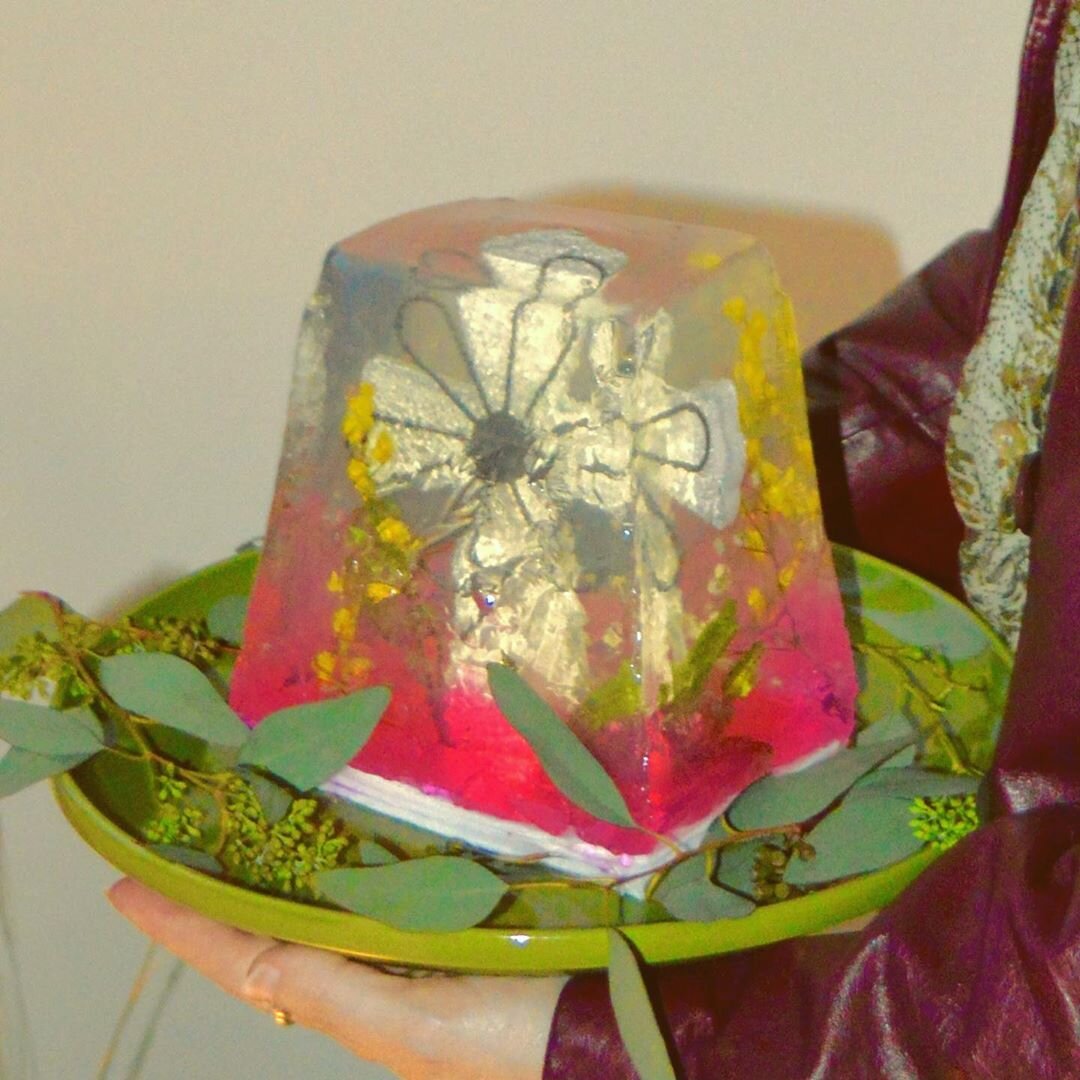Sharona Franklin
Birthed from non-linear paths, the work of Paid Technologies’ aspires to create a “prismatic world of fantasy and illustriousness through personal precarity”. Melding formality and psychedelia, Sharna Franklin ponders “Hippocrates said let food be thy medicine, but are meds a sin?”
What did you eat for breakfast this morning and what will you have for dinner tonight?
I made a cardamom, mango, avocado, saffron collagen vitamin d drop vanilla protein smoothie with cashew milk topped with whipped cream! My sweet friends Sara and Keiran surprised me and dropped off barbeque chicken, ribs and beef with asparagus and veggies! They dropped off a strawberry rhubarb pie from an old pie shop I used to work at too. I’m excited!
What are some of your favourite words?
Hmm... effervescent, surreal, amorphous, ambiguous, alchemical, spritely, translucent, psychedelic, chrysanthemum, zoanthropy.
What first drew you to using food or culinary practices to sculpt?
Cooking and baking have always been part of my life. I used to make myself honey butter sandwiches at 4 years old haha. I started baking shortly after that around 5. By the time I was 9 I was making entire floral cakes and stuff. I was big into making anything from my mind to come into the world, so it was natural to use materials that were accessible. Creating can be very empowering. I started making clothes with scraps in 2nd grade, hand dying fabrics with natural strawberries, onion skins and tea dyes in 4th grade. My friend and I travelled for a science project for our natural dyes when we were 9 or 10.
I had made all sorts of poems and drawings since so young, and sewed home items like pillows or curtains... I lived in between unfinished trailer homes, so we had to be industrious. I would lay tiles, finish drywall, garden, help prep cars for paint jobs in elementary school. My brother and I hand painted the giant sign logo for our stepdad’s auto shop. We were always making things. I was really into building and altering furniture when I was a teenager as well. I love that being creative occupies your mind and body, I’m usually happiest when creating. It’s so fulfilling to create objects and images that people can enjoy and use. Food is so essential but also can be connecting and transformative. Whenever I contribute to events or go to parties, I always try to bring special homemade ice-tea blends, infused liquor or homemade dishes. It’s fulfilling to share food as a gift when my body allows me, because it reaches our bodies and connects the five senses in ways that conversations can’t always reach.
In your practice, what is most important to you to try and communicate?
Great question! Ambiguity is important to me, but so is integrity. I strive for my work to be accessed on multiple levels, and disseminated in many levels, with honesty and metamorphosis. Through food, the ingredients carry a history, the aesthetics carry a narrative, the context carries a dialogue, and all can be important to different people. The way folks engage with my work tells a story in itself. I try to steer away from creating work that’s conceptually one dimensional: my main goal is that it would transcend with the message of temporality, connection, new beginnings and understandings of how we are connected to the natural, chemical, physical, spiritual, to one another and alternate realities. To be able to transport our senses can be really healing and help us understand one another. I love delineating our expectations and formal relationships to food. I really want my work to be transcendent, help us detach for a moment and hopefully feel more connected to ourselves and others.
You have previously described your work as a process of radical self-acceptance. How does this influence the concepts you choose to work with?
I think a major aspect of that is the idea of de-stigmatisation. So many kids like myself grow up in poverty, drugs, violence, feeling less-than in the world. There’s very little media representation of kids living within these circumstances, and the representation that exists is always quite negative. Just to know that we can overcome these narratives and occupy space in art, education and culture is so vital. I always felt like an outsider, whether it was from living in tiny towns or having an unconventional upbringing and being disabled. It took me forever to accept my past and feel enough self-worth to share my visions, voice and art publicly.
So many kids like myself who experienced childhood violence and also became part of the child social system feel so much shame. Childhood disability, sexual abuse and mental illness can also feel very shameful. Folks always asking when we will grow out of it? When will we “get better”?
I struggled so much with mental health and addiction when I was young, coping with the outcomes of my upbringing as did many of my 7 siblings. It’s very easy coming from that history, to imagine that oneself will never amount to anything, but we have to be vulnerable and step out of ourselves to grow. I finally graduated high school at 27 but rented my first apartment at 15. Non-linear paths are a huge part of many peoples’ experiences, but not represented as the societal norm. I think being open with the world about my experience was a challenge for me. I never shared my art on social media until I was about 30 years old. Deciding to share my creativity and practice with the world is a step towards accepting myself and new trajectories.
There is a preciosity and mesmorising regal eccentricity to your gelatines and cakes. What have been key aesthetic influences for you?
This question is fantastic, I love those descriptions. I think from being a kid in trailer parks I would always watch these fancy, formal, Christian middle-upper class dinners on satellite television, with their silver platters, and pretentiously placed utensils haha. My family were staunch atheists. They did heavy labour and were more into ACDC, heavy metal and tv trays than silver platters. I wanted my food and edible sculptures to create a prismatic world of fantasy and illustriousness through my own precarity. Mixing formality and psychedelia is reflective of my experience being a disabled body, constantly shifting inside, and trying to understand my experience through meds and fluctuating symptoms, while existing in a stuffy and icy bureaucratic system. Food can be reflective of culture, but it’s often just different techniques of the same ingredients which make it ‘fancy’ seeming, or unique, like how pancakes are made with basically the same basic ingredients as profiteroles. It’s all in the recipe, ratios and methods.
My dad cooked. He was a forager and hunter, so I learned about taking risks and being adventurous in cooking from that. I’ve always been drawn to the 60’s/70’s as a major influence, even as a child. My older sister taught me about the psychedelic movement when I was about 7 years old, and from then on, I was enamoured. Those movements looked so much softer than the way I grew up, I was drawn to the romantic notions of love, community and gentle imagery of that era. Some of the social justice movements of that time have stuck with me as well. These influences in combination with the science fiction-like, alien experience of hospitals and medical services. The bionic connections between disability, medical treatments, physical adaptation devices and the natural-self inspire me. Once I began to accept them as permanent fixtures in my life.
How significant is the role of flavour in your edible sculptures?
Mega! Flavour is so crucial. I most often have a flavour combination idea and then I’ll work with the palette and textures from there. I really try to work with complex flavours and textures. I wish everyone on the internet could eat the cakes together. It’s really special when we can get a group together and try new taste combinations. I love to work with foraged and unique ingredients, but I also love basic comfort food, since that's my roots. I did a community 2$ grilled cheese sandwiches sale with a griddle at a record shop as a fundraiser. In 2008, I used to make hand sized earl grey tea cakes, wrapped up in wax paper and sell them at the park. I used to give away things like homemade spelt bread, whipped butter and jam. I’d drop it off on my friends' doorsteps as a surprise. It doesn’t always have to be ornate or unique, but the intricate work is the most challenging to create and I love the concentration and creative playfulness I am able to express. It evolves based on what life is presenting at the time.
What flavours do you gravitate towards for your gelatines and cakes?
I like to boost both the savoury and sweet. I often start with the olfactory experience, and hope to form new connections between our thoughts, experiences and bodies. Newly born combinations and textures are important to me. I usually deliberate how dense I would like the food to be: how does that density and texture combo play with the palette? I use a lot of floral flavours, traditional Chinese medicine and Ayurvedic medicine, local plants. I live in China Town and supporting the local herbalists is really important. Sometimes I’ll use cloud ear fungus in my jellies, mulberries, or galangal root. I sometimes make fungus congee which is delicious with a bit of fresh green onion and sesame oil. Some of my favourite cake combos have been: fig, walnut, phyllo, chocolate ganache triple layer cake with psychedelic mushroom and gold flake fig essence jellies for my friend from the Balkan region. I made a cake for a friend’s citizenship ceremony of fresh rose, pistachio and Greek herbal mountain tea jellies. Another one that was really delicious: pine oil, CBD vanilla swirl cake. The pine tastes so citrusy. I’m mustering the courage to make myself a cake for the first time. I’d like it to be cocoa cardamom sponge with manuka honey chocolate ganache, and chicory water essence jellies. I always gravitate between Earthy, spicy, tangy and sweet.
You also make beautiful quilts. Are there parallels between your choice of flavours in your edible sculptures to your choice of say, colour or texture, in your quilts?
I think texture plays into it. My quilts are made with salvaged fabrics, and thrifted items. Some have patent vinyl, like the mirror glaze, velvet like buttercream, silk like flan. I'm a very tactile person and I require a lot of mental stimulation whether it's theory, by smell, touch or visual. Almost all my work is tied together. I love constellations of thought. I scent all my sculptures even when they are not edible. The most recent install had an antibody quilt at Kings Leap in NYC - the whole room was scented with clary sage oil. Olfactory installation is easily overlooked but I find it impactful. When I make mache sculptures I scent the mache paste with essential oils such as rose. I use scent and touch as methods of healing as well, as they can harness our neuroplasticity and shift our thought processes into new states.
What determines the physical form each outcome will take on?
That's a great question! Sometimes I will conceptualise an idea, and then mentally try it on into different forms, imagining whether it would suit a publication best, a print, poem, a physical sculpture, or a cake. At times, I work concepts into multiple mediums as well. I think because my creative practice is a major form of coping and escapism, my ideas often melt into one another in different areas of my practice. Considering the audience is important to me: if I really want to get my work to a broader age group and audience, I tone down my aesthetic and eccentric flair and strip it back into meme form, or something that is didactic and less texturally ambiguous.
Quilting and culinary both relate back to a domestic realm. Was there intention or reasoning behind working with outcomes traditionally associated with “the woman’s role”?
I think in multiple ways the home, the bed, the body and comfort and sustenance are reflected in these domestic forms. It goes back to care work, cleanliness, domestic support (which has been historically BIPOC women and underpaid women). Domestic support as a disabled person can be so hard to access financially and is also difficult to cultivate for ourselves as disabled bodies and bodies of chronic pain. Being homebound for so much of our lives, we often become more acquainted with our quilts than our friends or co-workers. Quilts become our second skin. Our meals often become our biggest daily physical challenge, especially living with digestive diseases. Nutrition and food scarcity are such a challenge, so is tolerating, absorbing and preparing food. I think due to this experience, I’ve appreciated food so much, especially during the times of relying on food banks or strangers providing meals when I was younger. I really appreciate being able to make and offer food: it’s so empowering as a person who is not always able to eat and cook and has been unable to access food so many times. It goes full circle.
There is also this fear of contaginiety of disability and food, which is a stigma I look to break. And the idea that physically disabled people cannot be caretakers, since disabled folks have been historically outcast from the role of procreation and becoming family matriarchs. This is partially due to eugenics, and that disabled folks are not encouraged to have families, and people like myself who take medications that inhibit us from procreating and giving birth. Along with this, it is very difficult to adopt children as a disabled person. There’s a reclamation aspect for me in celebrating this role of domestic work for disabled people. Another aspect is the diverse-able access of growing and sharing food, opposite to the cloistered bureaucracy of pharmaceuticals. Both can provide our bodies the molecular needs they require. Food is widely accessible and non-stigmatised, many of us require highly inaccessible and stigmatised meds that are globally unrecognised or rallied against such as pain meds and transgenic meds. Hippocrates said let food be thy medicine, but are meds a sin?
Your edible sculptures undeniably hold a very delicate rarity. What would you choose to be the soundtrack to your sculptures? If your work could sing, how would it sound?
Yes! Love music so much. I’ve made sound sculptures in the past and used to run a mix tape label called the Peace Library, make techno flyers and organize music events! My cakes would sound like Herbie Hancock ‘sextant’ a little bit, probably a little bit of some Philip Glass… some dance mix ‘94 mixed with Salt ‘n’ Pepa and Larissa ‘jay and jane’ song haha. Lou Reed... Naffi, Sister Nancy... there would be some Alice Coltrane, some deep Gloria Anne Taylor, some Loose Joints, Cela italo disco and, of course, RAMP ‘everybody loves the sunshine’.
What’s next on the horizon for you?
At this moment I’m coordinating a local mutual aid project called Care Club in Vancouver, to facilitate folks with resources offering to help, together with disabled folks requiring mutual aid support. I have a couple quarantine install exhibitions coming up, one will be a decomposing sculpture that will be viewed on live-stream, facilitated and organised by the amazing folks at Printed Matter St. Marks (NYC). We’re also doing a zoom prose and poetry reading titled Methodologies of Care, hosted by Printed Matter, featuring the work of Fabiola Ching, Hayley Cranberry, Amara Korley, Chandra Melting Tallow, Caroline Schub, Frankie Baker, Patty Lu and myself will be reading on the topics of care, community meals, friendship, healthcare, infrastructure, healing, sexuality, queerness, and mutual aid. I recently contributed work to two new disability-based publications that came out: Muff Mag, and Eco Crips. Check them out.
After these exhibitions, I’m really hoping to clear some time to continue working on my ongoing book project, it’s dear to me!
courtesy SHARONA FRANKLIN
interview KATE BISHOP
What to read next



















